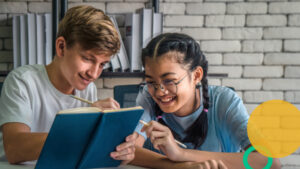Education Leader Resource: Bringing SEL Practices into Every Area of Instruction
As a teacher, I began each class with daily check-ins. Rather than jumping straight into our lesson, I started by inviting students to check-in with the class: how they were feeling, life updates, plans for the weekend, etc. Initially, students were often shy and reserved, but luckily teachers are skilled at navigating awkward silences! As the school year progressed, my daily “How is everyone?” question was immediately followed by a flood of hands bouncing in the air. Some students would share lighthearted updates, like plans to see a friend over the weekend or excitement about a new video game; Other students would share heavier challenges, like concerns about sick family members or struggles with stress and worry.
These daily check-ins were an intentional part of my practice. Though small and simple, they had a huge impact in my classroom: students practiced vulnerability and non-judgemental listening, they built community and discovered shared joys and struggles, and they experienced the power of being heard.
Students aren’t only learning academics in school, they are learning skills related to relationships, social- and self-awareness, decision-making, and more. These critical skills are necessary for students’ health and success in and out of the classroom.
With an explicit Social-Emotional Learning (SEL) curriculum, teachers and schools can have a significant impact on their students’ mental and emotional wellbeing.
Continue reading to learn more about the benefits of SEL and available resources for districts.
Increases Self-Awareness and Decision-Making Skills
Education Leader Resource Young childhood and adolescence is both a joyful and challenging time. Young people are learning about the world around them and their place in it, developing friendships, discovering interests and curiosities, and more. Young people are also learning how to grapple with pain and loss, how to identify, process, and regulate emotions, and how to navigate conflicts.
Oftentimes, behaviors that are read as intentionally disrespectful in schools are products of students’ struggles with things like impulse control and emotional self-regulation.
SEL curriculum teaches students important self-awareness and decision-making lessons and provides opportunities to practice those skills in real-life contexts. In my own classroom, I often created space for my students to have free-write journaling time, with prompts to promote self-reflection.
These self-awareness activities not only lead to less conflict in the classroom, but they equip students with essential tools for leading healthier lives in and out of school.
Supports Students’ Mental Health and Relationships
Given the challenges of our society, it is unsurprising that students are suffering from increased mental health challenges, particularly students with marginalized identities.
Education Leader Resource Although it doesn’t replace professional mental health services, SEL can provide students with important strategies, knowledge, and resources for coping and healing. This includes things like learning mindfulness practices, self-reflection exercises, and characteristics of healthy relationships. In this way, SEL can offer students a practical layer of mental health support.
SEL can also provide important lessons around addressing conflicts, celebrating differences, and identifying unhealthy relationship dynamics. This can have a significant impact on students’ development of positive peer relationships, decreasing instances of bullying in schools.
Strengthens Classroom Communities
Another key component of SEL is community-building. Through community building activities, students learn lifelong skills like teamwork, cooperation, and shared problem solving. These activities also foster strong student-teacher relationships, which leads to positive social and academic growth and more effective teaching. I certainly witnessed positive impacts–increased student participation, stronger community, and more productive group work–as a result of my own daily check-in practice.
When students shuffle from class to class, hour after hour, learning and practicing academic concepts back-to-back, burnout becomes almost inevitable. But when we prioritize opportunities for fun, play, and community care, we give students an intellectual break that they deserve, and in turn, we restore their capacity for learning.
Provides Opportunities for Discussions on Equity and Justice
Education Leader Resource Oftentimes, mental health struggles are the result of systemic injustices. How can we expect LGBTQIA+ students to maintain their mental health when they are victims of bullying and harassment? Or BIPOC students when they experience racism? Or students from low-income families when they are housing insecure?
Dr. Dena Simmons, a leader in the fields of teacher education and social-emotional learning, explains how SEL provides not only an opportunity but an obligation to interrogate systems of oppression that negatively impact our students’ mental health. These discussions, when handled with care, respect, and self-awareness, can encourage individual and collective healing. They can also lead to the creation of Project-Based Learning curriculum that address injustices, which can be an empowering act of making school engaging and relevant.
Where to Begin?
Understanding the significance of SEL is a necessary first step in holistically supporting your students, but then finding the resources to implement SEL in your district can be overwhelming.
BetterLesson offers professional learning resources–workshops, courses, coaching, and more–that center on SEL implementation. Similar to academic instruction, teachers need ongoing support around SEL curriculum and activities. BetterLesson helps districts implement professional learning plans tailored to your specific needs and student population.
Additionally, through a partnership with Kikori, BetterLesson provides educators guidance in putting Kikori’s over 800 SEL activities into action!



